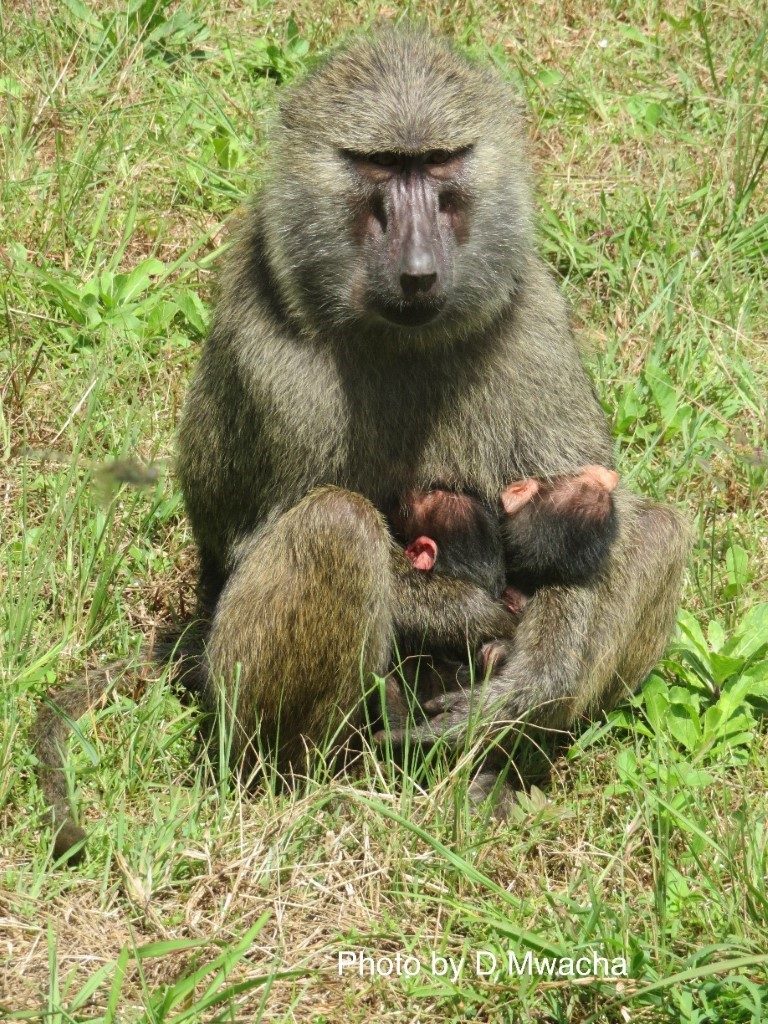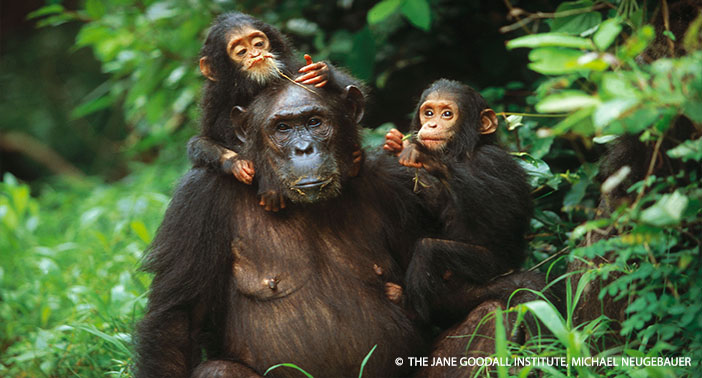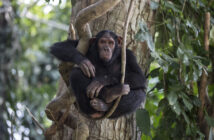An extremely rare event has just taken place in Gombe National Park. For the second time in Gombe history, an olive baboon has given birth to twins.
Until this spring, baboon twins have only been seen once at Gombe since Dr. Jane Goodall’s arrival in 1960. Since 1967, we have recorded 271 different females who have given birth, but only one female was observed to produce twins. The first twins were born in 1980, both males, of whom one survived only three weeks; his brother did well until leaving his mother’s group (which is how baboons maintain genetic diversity), at the normal transfer age of 7 years. This amounts to one pair of twins in 1,200 live births, something very rare indeed.

Giving birth to twins is quite unusual for any social primate. In humans, depending on what part of the world you we born, you have around a 1 in 115 (+-35) chance of being a twin. For the chimps in Gombe, we suspect the frequency is similar to that of humans (though we still don’t have enough data to be sure). During the 60-year study of chimpanzees, twins have been born on only six occasions (four in the Kasakela community, two in the Mitumba community).
In baboons however, the frequency appears to be much less common; perhaps one in 600 to 1,000 births! We have observed 1,200 births in 11 baboon troops in Gombe, and twins have only been observed on only two occasions. In another long-term study in Amboseli National Park in Kenya, yellow baboons have been observed giving birth to twins only twice in just under 2,000 births, and only one of the four infants survived.
So it was exciting that on 7th May we were called to the park headquarters at Mitumba to investigate news of twins in the camp group there…At first it appeared the report was mistaken, that she had only one baby: but after watching closely for some minutes we saw that there were indeed two, very small. The National Parks staff at Mitumba, who had called us, said that they were 2-3 days old. They appeared to be intact and the mother was calm and coping well, although because they could not yet cling to her she could only travel by supporting them to her chest with one arm, walking with difficulty tripedal.
Dr. Tony Collins
Survival is certainly a concern this new pair of twins. Even at the best of times in terms of food availability, large social non-human primates like baboons and chimpanzees are very rarely able to successfully raise twins. Unlike many mammals who have much higher twin survival rates, infant primates are entirely dependent upon their mother for many months (for food and locomotion), and the mothers have to travel great distances on a daily basis. Gremlin, who is still alive and well, is the only female (chimpanzee or baboon) to successfully raise her twins to adulthood.

So far, the mother and babies are doing well. Though the female does not belong to one of the study troops, she appears to be fairly high-ranking and have the support of adult female relatives. That could make all the difference for the survival of the twins. Though typical field research has been temporarily suspended at Gombe due to COVID-19 to ensure the safety of the other primates and humans, we will continue to provide updates of this exciting event.

Baboon twins born at Gombe.
A Direct Account from Dr. Tony Collins, head of Baboon Research at Gombe National Park:
Two baboon researchers Sufi Rukamata and Joseph Nyerenda returned there with our veterinarians Dr Dismas Mwacha of JGI and Dr Jane Rafael of National Parks. They quickly established that her twins are both females. Although the mother was still having some difficulty in carrying them both, by afternoon they were clinging better, freeing her arm so that she could now walk on all fours. The following day she was still doing fine, traveling easily, the infants were both suckling, and she was managing to feed herself as usual. However, her twins were drawing some attention from other baboons in the group, who would approach the mother closely, trying to see her infants or touch them: and even adult males were lying on the ground in front of her and peering at them!
This is not unusual, new infants attract a lot of interest, but it can become too much and put social pressure on the mother, even seeming stressful. However, this mother did not receive the levels of pressure as usually suffered by low-ranking mothers, from which we infer that she is quite high-ranking. This should help her a lot, as low-ranking females will be fearful to approach. However she is not absolutely the top, because one adult female came to supplant her a few times. She did receive insistent pressure from one adolescent female, almost full-size, who spent more time with her, grooming her and then trying to touch and even pull at the infants. The fact that this was tolerated by the mother at all, suggests that this adolescent may be her own young sister.
This very low rate of twins among the baboons is some contrast to the chimpanzees at Gombe, because since 1960, six pairs of chimpanzee twins have been born. However, it is clear that rearing twins is a challenge for chimpanzee mothers too: in only one case did both twins survive to adulthood, namely Gremlin’s daughters Golden and Glitter. Of Melissa’s twins, only one, Gimble, survived. For mothers Caramel and Rafiki, both twins died early (during respiratory outbreaks), and for Gaia, both died by misadventure. However, there is hope, because the sixth pair, Konyagi’s, are alive and well in Mitumba, and they have now reached 2.5 years of age.
So the twins-action at Gombe is all in Mitumba now, both baboon and chimpanzee! The prospects for the two baboons are still slender, as they are very small compared to normal newborns, but we do hope all four will do well.
Anthony Collins, May 13th 2020.






